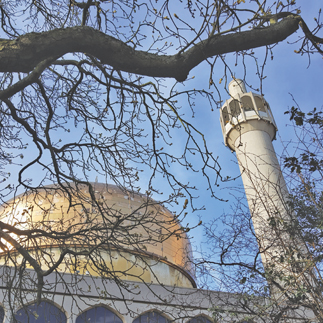A mosque in the UK could face a terror attack like Christchurch; so Home Office minister Ben Wallace admitted in debate in the House of Commons after the March 15 act of terrorism against two mosques in the New Zealand city. The threat is the same against any mosque and indeed any place of worship; but in terms of protective security mosques are not identical, writes Mark Rowe.
I have in mind a mosque on a terraced street in my town. I have never been in and seldom pass it; except it happens to have once been a Victorian-era, red-brick school that my mother went to. That was the experience for many Commonwealth immigrants to many northern English towns; unable to afford a purpose-built place of worship, they took on existing buildings. Those sites were no more built to face 21st century terrorism than they were built for cars. In security terms, typically they have little or no space from the pavement, giving the place of worship little or no room or time to fit layers of security to delay an attacker, whether a thief or terrorist.
Compare that with the London Central Mosque beside Regent’s Park (pictured) where Home Secretary Sajid Javid spoke at an interfaith event after Christchurch. Anyone walking past it can see it has a fence and CCTV; its perimeter includes a gate to cause vehicles to halt and allow the site to only let in authorised vehicles. While it would be grotesque however to further compare sites as if to set up some sort of security league table, it does point up the elementary and visible fact that some places are more secure than others. Yet the threat after Christchurch – and the whole point, the very definition, of terror, is that the attackers seek to plant fear in all.
Hence after Christchurch the Home Secretary increased funding for next year’s places of worship protective security scheme to £1.6m. Implied but largely unspoken was that mosques might have taken up less of the funding than they might have, since it was set up in 2016 (the Home Office was careful to point out that more than a third of grants under the places of scheme have been awarded to mosques).
The model, as some recognised in the aftermath of Christchurch, is the Community Safety Trust (CST), the Jewish body set up to advise and protect Jewish places of worship and schools. UK government support for synagogue security is more advanced (the places of worship protective security scheme does not allow grants for day to day security, only hardware; and the CST administers for the Home Office funding, some £13.4m in the year 2018-9, on security, including for commercial security guards.
As the then Home Secretary Amber Rudd set out in her speech at the annual CST dinner in March 2018, when she announced that £13.4m, it’s given absolutely because of the current threat; not out of the Home Office singling out the Jewish community for favour. And as CST said, at the dinner were Jews, Christians, Muslims, people of no faith, left wing, right wing, women and men. To stress, then, no favouritism between one faith or another. The more banal but perhaps painful truth is that Government helps those who help themselves by doing their bit by doing some organising.
Mosques, then, like sport, have to come to terms with the painful reality of modern terror – which is no different from terror of any age, whether the murder of Thomas A’Becket in Canterbury Cathedral in 1170 or the October 2018 attack on a synagogue in Pittsburgh. Sport like some imams in mosques may have felt that they were somehow insulated from outside hatred; protected by their good. That is, sadly, wishful and hazardous thinking. The Bangladesh cricket team on tour in New Zealand narrowly avoided being caught up in the massacre. The attack on the Sri Lankan cricket team in Pakistan in 2009, and on the Stade de France on the night of the Bataclan attack in 2015 showed that any sport is a target, the same as anything else. Nothing, to terrorists, is sacred.
Mosques, like the Houses of Parliament, airports and hospitals, must face the same dilemma – that they want to remain welcoming to the law-abiding, or else the terrorists succeed in a sense; yet their buildings have to be secured against those with evil intent. The world must face far right-wing terror – ‘no-one saw it coming’, Professional Security heard an Australian security manager in England say last week, of the Christchurch attack and the Australian attacker – the same as jihadism. The world may be ever more international, but so are the terrorists and the threats.
What was little remarked on is that the attack on two mosques happened in a place with such an overtly Christian name. To see the reality of a common enemy, religions have to overcome their past, for in past centuries religious believers suffered at the hands and in the name of believers of other religions. In the 21st century, the battle lines are not drawn between this religion and that, but between men of peace and godless men of hate.









